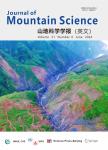Flowering and Fruiting Phenology of 24 Plant Species on the North Slope of Mt. Qomolangma (Mt. Everest)
Flowering and Fruiting Phenology of 24 Plant Species on the North Slope of Mt. Qomolangma (Mt. Everest)作者机构:Department of Environmental Sciences Sichuan University Muoziqiao Chengdu Sichuan 610065 P. R. China Department of Botany & Biodiversity Research Center University of British Columbia Vancouver Canada
出 版 物:《Journal of Mountain Science》 (山地科学学报(英文))
年 卷 期:2010年第7卷第1期
页 面:45-54页
核心收录:
学科分类:0709[理学-地质学] 0819[工学-矿业工程] 08[工学] 09[农学] 0303[法学-社会学] 083002[工学-环境工程] 0830[工学-环境科学与工程(可授工学、理学、农学学位)] 0818[工学-地质资源与地质工程] 0708[理学-地球物理学] 0705[理学-地理学] 0815[工学-水利工程] 0804[工学-仪器科学与技术] 0903[农学-农业资源与环境] 0816[工学-测绘科学与技术] 0706[理学-大气科学] 081602[工学-摄影测量与遥感] 0813[工学-建筑学] 0901[农学-作物学] 0704[理学-天文学] 0833[工学-城乡规划学] 081102[工学-检测技术与自动化装置] 0811[工学-控制科学与工程] 0713[理学-生态学] 0834[工学-风景园林学(可授工学、农学学位)]
基 金:supported jointly by 111 Project (Grant No. B08037) Project 6 of the National Basic Research Program of China (Grant No. 2005CB422006) a Natural Sciences and Engineering Research Council (Canada) discovery grant to RT
主 题:Alpine Global warming Phenology Qinghai-Tibet plateau
摘 要:Phenological background information for alpine species is limited from extremely high altitudes. Flowering and fruiting phenology was monitored for 24 plant species at 5,180 m a.s.1, near the base camp area on the north slope of Mt. Qomolangma (Mt. Everest) in Tibet, western China. The dates of first flowering, peak flowering, end of flowering, first fruiting, peak fruiting and flowering period were recorded. There was a wide variation in onset of flowering, long flowering duration, a relative synchrony between the onset of flowering and fruiting, and one species was exclusively vegetative. These results suggest that the species have evolved various phenological strategies as adaptations to the short growing season with limited resources and pollinators in this harsh alpine environment at extremely high elevations. With a background of global warming, local plant species will represent an advancing trend in onset of flowering.



